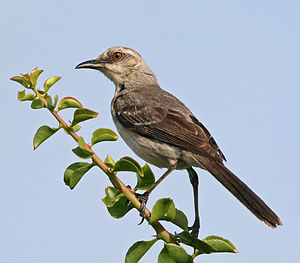Mockingbirds
| Mockingbirds | ||||||||||||
|---|---|---|---|---|---|---|---|---|---|---|---|---|

Tropical Mockingbird ( Mimus gilvus ) |
||||||||||||
| Systematics | ||||||||||||
|
||||||||||||
| Scientific name | ||||||||||||
| Mimidae | ||||||||||||
| Bonaparte , 1853 |
The mockingbirds (Mimidae) are a songbird family in the order of the passerine birds (Passeriformes). There are more than 30 species in two large and ten small or monotypical genera. It is a group of medium-sized, mostly around 30 cm long songbirds. The plumage is inconspicuous gray to brown in the majority of the species. An exception are the bluebirds, whose plumage is colored blue on the top. The birds , which also sing well, owe their name to their characteristic mocking , i.e. the imitation or adoption of unrelated sounds or singing motifs. With the thrushes (Turdidae), however, they are not closely related.
The mockingbirds take on the ecological role of starlings in the New World . These are also their closest relatives among the songbirds. They are very similar in shape and behavior, although the mockingbirds are less sociable.
Mockingbirds and the development of the theory of evolution
The mockingbirds are restricted to the American continent. Their range extends from Tierra del Fuego in the south to Canada in the north. Four species of mockingbirds, namely the Hood mockingbird , San Cristobal mockingbird , Galapagos mockingbird, and Charles mockingbird , are found in the Galapagos Islands . According to some authors, these species of mockingbirds found in the Galapagos Islands are more important for Darwin's contributions to the theory of evolution than the so-called Darwin's finches . With the latter, it was above all John Gould who recognized the importance of the specimens of finches that Darwin had collected. During his stay in the Galapagos Islands, however, the mockingbirds caught Darwin's attention because, on the one hand, they resembled those he knew from mainland South America, but at the same time had noticeable deviations. He found this so conspicuous that, unlike the Darwin's finches, he recorded the exact location for every specimen collected on the islands.
The mockingbirds found on the Galapagos Islands differ in many ways from their North American relatives. They frequently eat carrion, especially young turtles, lizards, seabirds and their eggs, and also feed on the carcasses of sea lions. In seabird colonies, they occasionally prey on living nestlings of the various seabirds that breed on the Galapagos Islands. They also collect ticks from the back of marine iguanas and even drink the blood of wounded boobies, sea lions, and marine iguanas. The breeding biology also differs significantly from that of the mainland species. On the Galapagos, the mockingbirds live in permanently expanded groups that defend a common territory. In three of the four species, the dominant pair is supported in the breeding efforts by the other group members. These so-called brood helpers are predominantly, but by no means exclusively, descendants of earlier broods.
All four Galapagos species are found on small to medium-sized islands. Among them, the Charles mockingbird , sometimes called the Floreana mockingbird, is particularly endangered. This species was still common on Floreana when Charles Darwin discovered it there in 1835, but by 1888 it had completely disappeared on the island. The reasons for this disappearance are not exactly known, but it is believed that the domestic rats introduced to this island play a major role. The Charles Mockingbird survived only because it is also found on two of Leana's side islands. It is one of the most endangered birds in the world, in 2008 there were fewer than fifty birds worldwide.
External system
While the mockingbirds traditionally form a family of their own, they are placed in the Sibley-Ahlquist taxonomy as Mimini in one of two tribes to the starlings (Sturnidae).
Internal system




-
Allenia
- Scaly mockingbird ( Allenia fusca )
-
Dither mockingbirds ( Cinclocerthia )
- Martinique's spotted thrush ( Cinclocerthia gutturalis )
- Trembling thrush ( Cinclocerthia ruficauda )

-
Dumetella
- Cats throttle ( Dumetella carolinensis )
-
Margarops
- Pearl-eye mockingbird ( Margarops fuscatus )
-
Melanoptila
- Glossy cat bird ( Melanoptila glabrirostris )
-
Bluebirds ( Melanotis )
- Blue Mock Thrush ( Melanotis caerulescens )
- Glaze mockingbird ( Melanotis hypoleucus )
-
Mimodes
- Socorrospottdrossel ( Mimodes graysoni )
-
Mockingbirds ( Mimus )
- Brown-backed mockingbird ( Mimus dorsalis )
- Tropical Mockingbird ( Mimus gilvus )
- Gundlach Mocking Thrush ( Mimus gundlachii )
- Long-tailed mockingbird ( Mimus longicaudatus )
- Patagonian Mockingbird ( Mimus patagonicus )
- Mockingbird ( Mimus polyglottos )
- Campos Mocking Thrush ( Mimus saturninus )
- Chiles Mocking Thrush ( Mimus thenca )
- White- banded mockingbird ( Mimus triurus )
-
Galapagos Mockingbirds ( Nesomimus )
- Hood mockingbird ( Nesomimus macdonaldi )
- San Cristobal Mockingbird ( Nesomimus melanotis )
- Galapagos Mockingbird ( Nesomimus parvulus )
- Charles Mockingbird ( Nesomimus trifasciatus )
-
Oreoscoptes
- Mountain Mocking Thrush ( Oreoscoptes montanus )
-
Ramphocinclus
- White-breasted mockingbird ( Ramphocinclus brachyurus )
-
Sickle mocker ( Toxostoma )
- Cactus Mockingbird ( Toxostoma bendirei )
- Gray mock thrush ( Toxostoma cinereum )
- Red-bellied mockingbird ( Toxostoma crissale )
- Crooked-billed mockingbird ( Toxostoma curvirostre )
- Red-backed mockingbird ( Toxostoma rufum )
- Cozumel's mockingbird ( Toxostoma guttatum )
- Desert Mocking Thrush ( Toxostoma lecontei )
- Long-billed mockingbird ( Toxostoma longirostre )
- Mocking Thrush ( Toxostoma ocellatum )
- California Mockingbird ( Toxostoma redivivum )
Web links
literature
- Dominic Couzens : Rare Birds - Survivors, Evolution Losers and the Lost. Haupt Verlag, Bern 2011, ISBN 978-3-258-07629-4 .